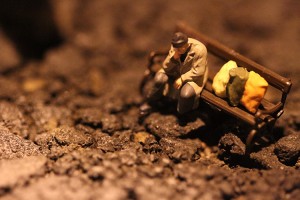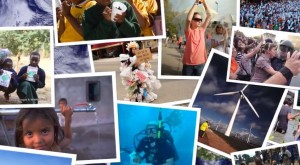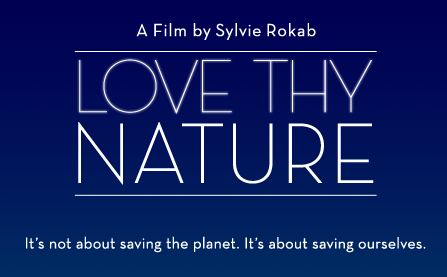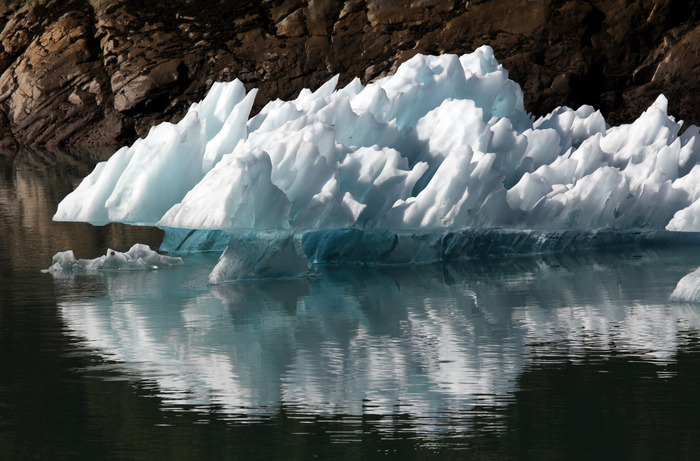Seed Story
 As a lone dandelion blossoms in an abandoned parking lot, it divides the lives of several miniature people in this experimental narrative short film by award winning film maker William D. Caballero.
As a lone dandelion blossoms in an abandoned parking lot, it divides the lives of several miniature people in this experimental narrative short film by award winning film maker William D. Caballero.
Filmed in an abandoned parking lot, using a cast of carefully painted tiny model figures this experimental film focuses on the destructive addictions humanity has suffered through the ages.
The film looks at the role of religion, capitalism, environmentalism and fascism through the perspective of macro photography.
Shooting took place over two months in the Summer of 2012, on a budget of less than$3,000. Torches, sparklers and smoke guns were used to create special effects.
Shooting was done close to the ground, during both days of 90 degree heat and heavy rainstorms. The biggest disruption proved to be breezes that at times blew entire sets away.
 Directed and conceived by William D. Caballero, it premiered at the 2013 Slamdance Film Festival and at numerous festivals across the world.
Directed and conceived by William D. Caballero, it premiered at the 2013 Slamdance Film Festival and at numerous festivals across the world.
As of April, 2013, SEED STORY has screened or will screen at numerous film festivals, including a world premiere at the SLAMDANCE FILM FESTIVAL in January, 2013. The festival had a less than 2% acceptance rate making entry into it more competitive than entry into Harvard!
AWARDS:
VANGUARD AWARD (for directors who are pushing the boundaries of experimental/non-linear film) at the 2013 ART OF BROOKLYN FILM FESTIVAL!
BEST SOUND DESIGN at the 2013 VISIONFEST
BEST SHORT FILM (Honorable Mention) at the 2013 PHILADELPHIA INDEPENDENT FILM FESTIVAL
OFFICIAL SELECTIONS
- VIMEO STAFF PICK
- SLAMDANCE FILM FESTIVAL
- ATLANTA FILM FESTIVAL
- RxSM FILM EXPO
- PHILADELPHIA INDEPENDENT FILM FESTIVAL
- VISIONFEST
- KAHBANG FILM FESTIVAL
- ART OF BROOKLYN FILM FESTIVAL
- VICTORIA TEXAS INDEPENDENT FILM FESTIVAL
- XICAN INDIE FILM FESTIVAL
- INDIANAPOLIS INTERNATIONAL FILM FESTIVAL
- GUANAJUATO INTERNATIONAL FILM FESTIVAL
- PORTLAND UNDERGROUND FILM FESTIVAL
- HARLEM INTERNATIONAL FILM FESTIVAL
More to come!
To see a new short film consisting of deleted scenes from Seed Story, click here: vimeo.com/74943004
The film below was created using deleted scenes from the Seed Story film.
For more information on the project, visit wilcab.com/seedstory/
Directed, produced, shot, edited, animated, and scored by William D. Caballero
“Special thanks to the art crew and production team. I couldn’t have done it without you.”
Gasland, the Fracking Truth
It’s amazing that what took mother nature millions of years to buid can be destroyed in a few hours with heavy machinery” – Josh Fox
Gasland: The Movie
“The largest domestic natural gas drilling boom in history has swept across the United States. The Halliburton-developed drilling technology of “fracking” or hydraulic fracturing has unlocked a “Saudia Arabia of natural gas” just beneath us.
When filmmaker Josh Fox is asked to lease his land for drilling, he embarks on a cross-country odyssey uncovering a trail of secrets, lies and contamination. A recently drilled nearby Pennsylvania town reports that residents are able to light their drinking water on fire. This is just one of the many absurd and astonishing revelations of a new country called GASLAND. Part verite travelogue, part expose, part mystery, part bluegrass banjo meltdown, part showdown.”
Gasland- Reviews (at bottom of page)
The Oil Industry has tried to discredit the film and the issues it raises via a disinformation campaign, including a video in direct response to the film .
Gasland replied to its accusations in detail on its website.
Green MP Caroline Lucas Arrested in Fracking Protest
Why would Green Party Member of Parliament be willing to face arrest in order to demonstrate against the process of fracking in the UK?
Caroline Lucas, the MP for Brighton Pavilion said:
“Along with everyone else who took action today, I’m trying to stop a process which could cause enormous damage for decades to come. People today, myself included, took peaceful non-violent direct action only after exhausting every other means of protest available to us.
Despite the opposition to fracking being abundantly clear, the government has completely ignored the views of those they are supposed to represent. When the democratic deficit is so enormous, people are left with very little option but to take peaceful, non-violent direct action.”
The Department o Energy and Climate Change did not respond to requests for comment on the protests.
When one reads documentation concerning the effects of Fracking and the Oil Industry on human health and the environment, it becomes very clear why this issue is one worth protesting about.
THE ENDOCRINE DISRUPTION EXCHANGE
“To date, no chemical in use has been thoroughly tested for its endocrine disrupting effects. Traditional toxicological testing protocols were not designed to test for endocrine disruption and to test at ambient or low exposure levels.”
The Endocrine Disruption Exchange is one of the few organisations that has studied the effects of products and chemicals used in the Oil/Gas industry.
Its findings are very disturbing.
Extract:
T he technology to recover natural gas depends on undisclosed types and amounts of toxic chemicals.
A list of 944 products containing 632 chemicals used during natural gas operations was compiled. Literature searches were conducted to determine potential health effects of the 353 chemicals identified by Chemical Abstract Service (CAS) numbers.
-
More than 75% of the chemicals could affect the skin, eyes, and other sensory organs, and the respiratory and gastrointestinal systems.
-
Approximately 40-50% could affect the brain/nervous system, immune and cardiovascular systems, and the kidneys;
-
37% could affect the endocrine system; and
-
25% could cause cancer and mutations.
-
These results indicate that many chemicals used during the fracturing and drilling stages of gas operations may have long-term health effects that are not immediately expressed.
- In addition, an example was provided of waste evaporation pit residuals that contained numerous chemicals on the Comprehensive Environmental Response, Compensation, and Liability Act (CERCLA) and Emergency Planning and Community Right to Know Act (EPCRA) lists of hazardous substances.
- The discussion highlights the difficulty of developing effective water quality monitoring programs.
- To protect public health we recommend full disclosure of the contents of all products, extensive air and water monitoring, coordinated environmental/human health studies, and regulation of fracturing under the U.S. Safe Drinking Water Act.
Extracting, processing, and burning fossil fuels (natural gas, oil and coal) introduces huge volumes of harmful chemicals into our environment. These chemicals, and the tens of thousands of chemical products synthesized from them, are now present in every environment on earth, including the womb. Extremely low concentrations of many chemicals can damage the endocrine system of our bodies by interfering with the intricate, delicate network of natural chemical interactions critical to healthy development and normal function.
n 1991, an international group of experts stated, with confidence, that “Unless the environmental load of synthetic hormone disruptors is abated and controlled, large scale dysfunction at the population level is possible.”
They could not perceive that within only ten years, a pandemic of endocrine-driven disorders would begin to emerge and increase rapidly across the northern hemisphere. Today, less than two decades later, hardly a family has not been touched by Attention Deficit Hyperactivity Disorder, autism, intelligence and behavioral problems, diabetes, obesity, childhood, pubertal and adult cancers, abnormal genitalia, infertility, Parkinson’s or Alzheimer’s Diseases.
TEDX’s findings confirm that each of these disorders could in part be the result of prenatal exposure to chemicals called endocrine disruptors. TEDX has also confirmed that the feed stocks for most endocrine disrupting chemicals are derived from the production of coal, oil, and natural gas. It is clear that endocrine disruption, like climate change, is a spin-off of society’s addiction to fossil fuels. Setting aside the effects of endocrine disruptors on infertility, and just considering their influence on intelligence and behavior alone, it is possible that hormone disruption could pose a more imminent threat to humankind than climate change
Fracking and Hazardous Waste
Many people and animals have fallen ill since fracking started in their area. The process of fracking pumps toxic chemicals at high pressure into the earth in order to cause minor earthquakes that loosen deposits of natural gas that have been trapped in the rock for millions of years. The process threatens to pollute groundwater and an estimated 30% to 70% of poisoned water is estimated to resurface and continue to surface for the life of the well (20 – 30 years)
Why is this Allowed?
Many of the chemicals used in the process of fracking are considered hazardous waste.
Why are these toxins being allowed to be pumped into the earth all over the USA when they are a real danger to drinking water supplies?
“In his second week in office, George W. Bush created the energy task force, officially known as the
National Energy Policy Development Group, with Vice President Dick Cheney as chairman. In
its mission, NEPDG aimed to: “develop a national energy policy designed to help the private
sector. . . .”
Only when pressed by EPA chief Christie Todd Whitman did Cheney remove a recommendation to
exempt fracturing from the task force’s final report. Whereupon, the Bush/Cheney Energy Bill of
2003 included a provision to exempt fracturing from EPA drinking water regulation — but Congress
removed the provision from the final draft.
Whereupon, in the Energy Policy Act of 2005, Congressmen James Inhofe of Oklahoma and Joe
Barton of Texas inserted language to:
“Amend the Safe Drinking Water Act of 1996 to exempt
hydraulic fracturing related to oil and gas production . . . and, thus, exclude this practice from . . .
regulations related to the protection of underground sources of drinking water.”
– Steve Coffman (on Gasland’s official reply to the Gas Industry’s attempt to discredit the film.)
BBC Horizon Documentary on Fracking
The BBC Program: Horizon made a documentary examining the process of Fracking which questions whether there were indeed (as the Oil/Gas companies would have us believe) no risks involved to people living near the the Fracking wells.
Communities did appear to be experiencing high levels of illness. It seemed strange that so little was understood about the causes of the illnesses. One factor may have been that many people had received compensation and had signed gagging clauses which did not allow them to discuss their situation.
Plenty of people did seem willing to talk about afflictions to themselves and animals in the area that appeared since fracking began.
The reason for lack of clarity about the cause became apparent when the rights of industry to avoid transparency was raised.
Money is More Important than the Health of USA Citizens.
Drilling companies in the USA are allowed to keep the chemicals used in their procedures a secret, even when they may be causing a health risk. This makes it almost impossible for people to know what might have be causing the illnesses that have occurred since the fracking began in their areas.
Medical doctors have managed to get special permission to be request this information from the companies.
Doctors Can’t Tell Their Patients
One doctor has treated people with leisions to their faces that she thinks might be related to chemicals from fracking . The drilling companies only allow her access to the information about chemicals they use, under the strictest of conditions. They insist the doctors sign a confidentiality statement which means they are unable to tell their patients what they have discovered are causing their illnesses.
If a doctor (that has been given the information about the chemicals) has now been able to diagnose the cause of the medical problem decides they need to refer the patient to another medical specialist, they are not allowed to pass on the information to the other doctor or medical specialist.
“for physicians in order to take care of your patients, there needs to be transparency and this completely breaks that down, so yes it’s very upsetting for us because we want people to get better, but if you can’t explain to someone what’s happening to them, how do you get them better… and then how do you find out if other members of their family may have been exposed .. or other people in the area may have been exposed because no one can talk about it. So it really goes against any type of modern medicine“
Reviews of Gasland
Robert Koehler of Variety referred to it as “one of the most effective and expressive environmental films of recent years… Gasland may become to the dangers of natural gas drilling what Silent Spring was to DDT.”[18]
Eric Kohn of IndieWire wrote, “Gasland is the paragon of first person activist filmmaking done right… By grounding a massive environmental issue in its personal ramifications, Fox turns Gasland into a remarkably urgent diary of national concerns.”[19]
Stewart Nusbaumer of the Huffington Post wrote “Gasland… just might take you from outrage right into the fire of action.”[20]
Gasland currently holds a 97% rating on the film site Rotten Tomatoes based on 37 reviews.[21] Mark Kermode of BBC Radio 5 Live gave it a generally positive review, criticizing its similarity to other recent oil documentaries, yet praising its “extraordinary visual kick”. He said “it is a very interesting story which is made better by the fact that the visuals of it are very poetic, very lyrical”, and felt that its themes and ideas were relevant and well presented.
The Denton Record Chronicle said “Fox decides that his own backyard in Pennsylvania isn’t his exclusive property… Set to his own banjo music and clever footage, Gasland is both sad and scary… if your soul isn’t moved by the documentary, yours is a heart of shale.”[22]
Bloomberg News critic Dave Shiflett wrote that Fox “may go down in history as the Paul Revere of fracking.”[23]
Chicago TimeOut gave Gasland four out of five stars.[24]
In Australia, film critic Julie Riggs called the documentary a “horror movie, and a wake-up call.”[25][26]
Fort Worth Business Press writer John-Laurent Tronche talks about the growing number of documentaries “that aim to shed a light on what they call a dirty, destructive practice: shale gas exploration. And although oil and gas supporters have labeled the motion pictures as radical propaganda, a local drilling activist said they’re part of a larger, critical look into an ever-growing industry.”[27]
Read MoreEarth Day 2013 – Share Your Photos
Earth Day 2013: The Face of Climate Change
Climate change has many faces.
A man in the Maldives worried about relocating his family as sea levels rise, a farmer in Kansas struggling to make ends meet as prolonged drought ravages the crops, a fisherman on the Niger River whose nets often come up empty, a child in New Jersey who lost her home to a super-storm, a woman in Bangladesh who can’t get fresh water due to more frequent flooding and cyclones…
And they’re not only human faces.
They’re the polar bear in the melting arctic, the tiger in India’s threatened mangrove forests, the right whale in plankton-poor parts of the warming North Atlantic, the orangutan in Indonesian forests segmented by more frequent bushfires and droughts…
These faces of climate change are multiplying every day.
For many, climate change can often seem remote and hazy – a vague and complex problem far off in the distance that our grandchildren may have to solve. But that’s only because they’re still fortunate enough to be insulated from its mounting consequences. Climate change has very real effects on people, animals, and the ecosystems and natural resources on which we all depend. Left unchecked, they’ll spread like wildfire. 
Luckily, other faces of climate change are also multiplying every day.
Every person who does his or her part to fix the problem is also a Face of Climate Change: the entrepreneurs who see opportunity in creating the new green economy, the activists who organize community action and awareness campaigns, the engineers who design the clean technology of the future, the public servants who fight for climate change laws and for mitigation efforts, the ordinary people who commit to living sustainably…
Between now and Earth Day, we’ll collect and display images of people, animals, and places directly affected or threatened by climate change – as well as images of people stepping up to do something about it. We’ll tell the world their stories.
But we need your help. We need you to be climate reporters. So, send us your pictures and stories that show The Face of Climate Change.
On and around Earth Day, an interactive digital display of all the images will be shown at thousands of events around the world, including next to federal government buildings in countries that produce the most carbon pollution. The display will also be made available online to anyone who wants to view or show it. Together, we’ll highlight the solutions and showcase the collective power of individuals taking action across the world. In doing so, we hope to inspire our leaders to act and inspire ourselves to redouble our efforts in the fight against climate change.
http://www.earthday.org/2013/about.html
Read MoreThe Oscar 2013 Winners
The Oscars 2013 Award Ceremony was held on Sunday 24 February
The Winners
Best Picture: Argo
Best Actor: Daniel Day-Lewis
Lincoln
Best Acress: Jennifer Lawrence
Silver Linings Playbook
Best Actor – in a Supporting Role: Christoph Waltz
Django Unchained
Best Actress – in a Supporting Role: Anne Hathaway
Les Misérables
Best Animated Feature Film: Brave
Best Cinematography: Life of Pi
Best Costume Design: Anna Karenina
Jacqueline Durran
Best Directing: Life of Pi
Ang Lee
Best Documentary Feature: Searching for Sugar Man
Malik Bendjelloul and Simon Chinn
Best Documentary Short: Inocente
Sean Fine and Andrea Nix Fine
Best Film Editing: Argo
William Goldenberg
Best Foreign Language Film: Amour
Austria
Best Makeup and HairstylingA: Les Misérables
Lisa Westcott and Julie Dartnell
Best Music – Original Score: Life of Pi
Mychael Danna
Best Music – Original Song: “Skyfall” from Skyfall
Music and Lyric by Adele Adkins and Paul Epworth
Best Production Design: Lincoln
Rick Carter (Production Design); Jim Erickson (Set Decoration)
Best Short Film – Animated: Paperman
John Kahrs
Best Short Film – Live Action: Curfew
Shawn Christensen
Best Sound Editing: Skyfall
Per Hallberg and Karen Baker Landers
Best Sound Mixing: Les Misérables
Andy Nelson, Mark Paterson and Simon Hayes
Best Visual Effects: Life of Pi:
Bill Westenhofer, Guillaume Rocheron, Erik-Jan De Boer and Donald R. Elliott
Best Writing – Adapted Screenplay: Argo
Written by Chris Terrio
Best Writing – Original Screenplay: Django Unchained
Written by Quentin Tarantino
Read More
Love Thy Nature: A Film About Who We Are
What we fall in love with, we protect.
When we fall in love, we transform.
Through loving and protecting nature,
we can heal ourselves and ensure
a future for our children. ”
— Sylvie Rokab —
A film in the making by award-winning documentary film maker Sylvie Rokab
who says of it “this is the film I was born to make,”
“As far as we know, only our planet gives birth to life
and among all species on earth ours is the most gifted
But have our gifts taken us too far away from what sustains us?
Take a journey through the new era of human evolution
where our hearts and minds are inspired by the wonders of nature…”
The film is currently on Kickstarter and has 10 days to go to reach its required funding
Love Thy Nature demonstrates how communion with the natural world transforms us as individuals and communities.
And that transformation encourages us to not only restore our ecosystems, but also to embrace our role as a species of double-wisdom: as stewards of our planet, including our human family.
Read More



